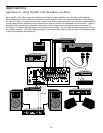
22
Using Aux Sends and Returns
The MPL 1204’s two Auxiliary sends allow you to combine the signal from
multiple channels and send the resulting mix to external devices such as effects
processors. When an Aux send knob is at its 2 o’clock “0” position, the signal is
routed with unity gain (that is, no boost or attenuation). As it is turned clockwise
from the 0 position, the signal is boosted; as it is turned counterclockwise from
the 0 position, it is attenuated. Aux send 1 is
pre-fade (but post-eq); that is, the
level of the signal is determined solely by the channel’s Trim control and its EQ
settings. In contrast, Aux send 2 is
post-fade (and post-eq); that is, the level of
the signal is affected by the channel’s Trim control, equalizer settings, and Level
control.
The MPL 1204 also provides two stereo Auxiliary returns. These allow you to
return signal from outboard devices in stereo pairs. Each of the stereo Auxiliary
returns is somewhat similar to a stereo channel, except that a signal being
brought into to a channel can be equalized if necessary and optionally sent on to
other outboard devices (via Aux sends or channel inserts). In practice, you’ll
probably want to use the Auxiliary returns to bring in signal from connected
effects processors. If the effects processors have stereo outputs, they should be
connected to both the left and right Aux return inputs so that their stereo integrity
is retained. If they have mono outputs, you can route them to either the left or
right inputs and then use the Aux return Balance control to adjust the relative
level of each paired signal. In this way, you can actually connect up to four
monophonic devices to the MPL 1204’s Aux return section.
When an Aux return Balance knob is placed at its center (detented) position,
both the left and right signals are at equal strength. When moved left of center,
the left input signal remains the same but the right input signal is attenuated;
when the knob is moved right of center, the right input signal remains the same
but the left input signal is attenuated. When placed fully counterclockwise, only
the left input is heard (panned hard left); when placed fully clockwise, only the
right input is heard (panned hard right).
Signal arriving at the left Aux return input is automatically panned hard left and
signal arriving at the right input is automatically panned hard right. The
MPL 1204 Aux return jacks are unbalanced stereo inputs, with the tip carrying
the left input signal and the ring carrying the right input signal (the sleeve carries
common ground), as shown in the wiring diagram on page 12 of this manual.
Insertion of a monophonic 1/4" jack into an Aux return will result in the incoming
signal being automatically routed to the left input only (and therefore panned
hard left).
The signal arriving at each of the two stereo Aux returns can be routed to either
of the two bus pairs (1/2 or 3/4) with the use of the associated Aux Return bus
switch (as described in #2 on page 6). The signal can then be routed to the
Master and Control Room outputs by pressing in the associated bus L/R switch
(as described in #14 on page 8). Note that Aux Returns cannot be soloed and
so cannot be monitored over headphones.
∞
+10
0
∞
+10
0
AUX 1
AUX 2
PRE
POST
MUTE
3/4
AUX RETURNS
STEREO
MUTE
3/4
∞
+10
0
AUX RET.1/2
R
BALANCE
L
∞
+10
0
AUX RET.3/4
R
BALANCE
L


















